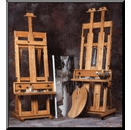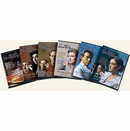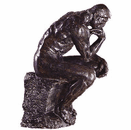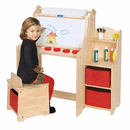Notable Artists of Italy
Notable Artists of Italy
by: Meagan Wilson
Famous Italian Artists
Italy has given rise to some of the greatest artistic talents the world has ever known. From Leonardo da Vinci and Michelangelo Buonarroti to Sofonisba Anguissola and Umberto Mastroianni, the list of famous Italian artists and visionaries is extremely long. As there are too many noteworthy artists of Italian birth to do them all justice here, a few individuals are highlighted in this article.
The period of European history from approximately 1330 to 1550 is called the Renaissance. It marks the progression from the medieval period into the early modern era. The Renaissance began in Italy, and was a movement inspired by the philosophy of humanism, which placed more emphasis on individual accomplishments than did medieval ideologies. The influence of Greek and Roman philosophy and mythology can be seen in the works of period artists.
Leonardo da Vinci (1452– 519) is possibly the most famous Italian artist of all time, unless you count fashion designer Georgio Armani. In addition to being a master painter and sculptor, da Vinci was a scientist, mathematician, architect, engineer, writer, astronomer and botanist. Da Vinci’s Mona Lisa and The Last Supper are among the most well known paintings of the period. Leonardo da Vinci was ahead of his time and created many sketches of mechanisms that were not used until well after his death, such as flying machines and parachutes.
Michelangelo Buonarroti (1475–1564) spent four years painting the Vatican’s Sistine Chapel ceiling for Pope Julius II. At the completion of that grand project, 343 biblical figures adorned the ceiling of the chapel, in scenes that include oft-reproduced The Creation of Adam. Michelangelo also created The Last Judgment, which is among the frescoes decorating the sanctuary’s walls. Though Michelangelo was a highly successful painter, he was primarily a sculptor. The statues David and Pieta are among his most prestigious works.
Masaccio (1401– 428), Donatello (1386–1486) and Brunelleschi (1377–1446) are credited with inspiring the art styles that characterized the Italian Renaissance. Masaccio was a painter, Donatello a sculptor, and Brunelleschi was the architect of the Duomo of Florence, the Florence cathedral cupola. Construction had begun on the church in 1299, but lacked a roof for 175 years after its construction because the architectural skill to create the dome had not yet caught up with the original designer’s vision.
Female artists received little encouragement or acceptance in Renaissance and Early Modern Europe. Nevertheless, there were a few determined souls who managed to gain recognition for their talents. Two such women are Sofonisba Anguissola (1531–1625) and Artemisia Gentileschi (1593–1652). Sofonisba was the eldest of seven children born to a Cremona merchant. Sent to study at the Bernardino Campi workshop by her father, Sofonisba refined her skills there and at the Bernardino Gratti studio. Sofonisba served as court painter for Philip II of Spain, and art instructor to the queen. She is known for her realistic, lifelike portraits.
Artemisia Gentileschi was born in Rome, the daughter of a painter. Artemisia’s father raised her in the Roman art community, introducing her to the work of prominent artists such as Michelangelo. Artemisia’s life and art were marked by a traumatic and humiliating incident involving Agostino Tassi, a fellow artist. In her painting Judith Beheading Holofernes, based on the deuterocanonical account of Judith, Artemisia quite likely expressed both her considerable talent and feelings toward Tassi.
Other leading Italian artists from the Renaissance period onward include the Mannerist painter Tontoretto (1518-1594), the Baroque painter Caravaggio (1571-1610), a prominent painter of the Macchiaioli, a sort of pre-impressionist group of Italian artists named Giovanni Fattori (1825-1908), sculptor Marino Marini (1901-1980), Pietro Annigoni (1910-1988), who specialized in portraits and frescoes, and sculptor Umberto Mastroianni (1910-1998), who participated in the Italian Resistance during WWII, and created many monuments after the war.
The Italian artists mentioned above are merely a few selections from Italy’s impressive roster of artistic geniuses. In addition to the prodigious number of Italian painters, sculptors and architects who have contributed to the traditions of fine art, Italy has given rise to some of the world’s most prestigious fashion houses. Italy truly is a well of creative talent and vision, gratifying and inspiring art students, collectors and appreciators the world over.
Notable Artists of Italy
References:
"Italian Renaissance (1330-1550)." SparkNotes. SparkNotes LLC, 2011. Web. 11 Aug 2011.
"Italian Renaissance ." Wikipedia. Wikimedia Foundation, Inc., 03 Aug 2011. Web. 11 Aug 2011.
"Famous Artists of Italy." thinkquest. Oracle Education Foundation, n.d. Web. 11 Aug 2011.
Panico, Vito. "Most famous Italian artists the world has ever known." International Business Times 10 May 2011. n. pag. Web. 11 Aug. 2011.
Austin, Jamie Sue. "Artisti Donne in Italia- Italian Women Artists." life in italy. life in italy, n.d. Web. 11 Aug 2011.
"Famous Italians: List of famous people from Italy. Artists, musicians, politicians, etc. ." day translations. Day Translations, Inc., n.d. Web. 11 Aug 2011.
Bellis, Mary. "Inventions of Leonardo DaVinci." About.com - Inventors. About.com, 2011. Web. 11 Aug 2011.
"Judith Beheading Holofernes." Wikipedia. Wikimedia Foundation, Inc., 09 Aug 2011. Web. 11 Aug 2011.
"Italian art." Wikipedia. Wikimedia Foundation, Inc., 28 July 2011. Web. 11 Aug 2011.
Marshall, Lee. "Obituary: Umberto Mastroianni ." Independent London 09 March 1998. n. pag. Web. 11 Aug. 2011.
by: Meagan Wilson
Famous Italian Artists
Italy has given rise to some of the greatest artistic talents the world has ever known. From Leonardo da Vinci and Michelangelo Buonarroti to Sofonisba Anguissola and Umberto Mastroianni, the list of famous Italian artists and visionaries is extremely long. As there are too many noteworthy artists of Italian birth to do them all justice here, a few individuals are highlighted in this article.
The period of European history from approximately 1330 to 1550 is called the Renaissance. It marks the progression from the medieval period into the early modern era. The Renaissance began in Italy, and was a movement inspired by the philosophy of humanism, which placed more emphasis on individual accomplishments than did medieval ideologies. The influence of Greek and Roman philosophy and mythology can be seen in the works of period artists.
Leonardo da Vinci (1452– 519) is possibly the most famous Italian artist of all time, unless you count fashion designer Georgio Armani. In addition to being a master painter and sculptor, da Vinci was a scientist, mathematician, architect, engineer, writer, astronomer and botanist. Da Vinci’s Mona Lisa and The Last Supper are among the most well known paintings of the period. Leonardo da Vinci was ahead of his time and created many sketches of mechanisms that were not used until well after his death, such as flying machines and parachutes.
Michelangelo Buonarroti (1475–1564) spent four years painting the Vatican’s Sistine Chapel ceiling for Pope Julius II. At the completion of that grand project, 343 biblical figures adorned the ceiling of the chapel, in scenes that include oft-reproduced The Creation of Adam. Michelangelo also created The Last Judgment, which is among the frescoes decorating the sanctuary’s walls. Though Michelangelo was a highly successful painter, he was primarily a sculptor. The statues David and Pieta are among his most prestigious works.
Masaccio (1401– 428), Donatello (1386–1486) and Brunelleschi (1377–1446) are credited with inspiring the art styles that characterized the Italian Renaissance. Masaccio was a painter, Donatello a sculptor, and Brunelleschi was the architect of the Duomo of Florence, the Florence cathedral cupola. Construction had begun on the church in 1299, but lacked a roof for 175 years after its construction because the architectural skill to create the dome had not yet caught up with the original designer’s vision.
Female artists received little encouragement or acceptance in Renaissance and Early Modern Europe. Nevertheless, there were a few determined souls who managed to gain recognition for their talents. Two such women are Sofonisba Anguissola (1531–1625) and Artemisia Gentileschi (1593–1652). Sofonisba was the eldest of seven children born to a Cremona merchant. Sent to study at the Bernardino Campi workshop by her father, Sofonisba refined her skills there and at the Bernardino Gratti studio. Sofonisba served as court painter for Philip II of Spain, and art instructor to the queen. She is known for her realistic, lifelike portraits.
Artemisia Gentileschi was born in Rome, the daughter of a painter. Artemisia’s father raised her in the Roman art community, introducing her to the work of prominent artists such as Michelangelo. Artemisia’s life and art were marked by a traumatic and humiliating incident involving Agostino Tassi, a fellow artist. In her painting Judith Beheading Holofernes, based on the deuterocanonical account of Judith, Artemisia quite likely expressed both her considerable talent and feelings toward Tassi.
Other leading Italian artists from the Renaissance period onward include the Mannerist painter Tontoretto (1518-1594), the Baroque painter Caravaggio (1571-1610), a prominent painter of the Macchiaioli, a sort of pre-impressionist group of Italian artists named Giovanni Fattori (1825-1908), sculptor Marino Marini (1901-1980), Pietro Annigoni (1910-1988), who specialized in portraits and frescoes, and sculptor Umberto Mastroianni (1910-1998), who participated in the Italian Resistance during WWII, and created many monuments after the war.
The Italian artists mentioned above are merely a few selections from Italy’s impressive roster of artistic geniuses. In addition to the prodigious number of Italian painters, sculptors and architects who have contributed to the traditions of fine art, Italy has given rise to some of the world’s most prestigious fashion houses. Italy truly is a well of creative talent and vision, gratifying and inspiring art students, collectors and appreciators the world over.
Notable Artists of Italy
References:
Copyright © 2002-2025 Madison Art Shop™ LLC. All Rights Reserved.
















